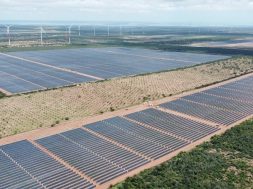
The $16 billion plan to beam Australia’s Outback sun onto Asia’s power grids
SYDNEY : Could Australia, one of the world’s biggest exporters of coal and natural gas, become a solar superpower?
The island continent, distant from Asia’s megacities, plans to capture the plentiful Outback sun, store it in giant batteries until nightfall and transmit it to Singapore along a watermelon-width cable traversing 2,800 miles of sea floor, including a deep trench.
The Australia-ASEAN Power Link, which is part-owned by two Australian billionaires and was endorsed last month by the Australian government, may be the most ambitious renewable energy project underway anywhere. And it could mark a new chapter in the history of energy: the intercontinental movement of green power.
Eventually, the project’s backers believe that Australia eventually can supply cheap solar power to a pan-Asian electricity grid, lifting living standards for millions of people and reducing the region’s dependence on coal and natural gas, which are big contributors to global warming.
“The cool new thing is to seriously talk about moving renewable energy around long-term as the carbon-free alternative to the existing fossil fuel trade,” said Peter Cowling, chief executive of Vestas Australia, a wind farm builder. “This is the most plausible solution I have seen to helping Asia decarbonize its energy supply.”
Scheduled to start operating in 2027 at a cost of about $16 billion, the project would combine the world’s largest solar farm, the largest battery and longest submarine electricity cable. It would produce three gigawatts of power, the equivalent of 9 million rooftop solar panels.
The specifications are so complicated that it will be designed by computers using artificial intelligence, according to David Griffin, a solar and wind farm builder who said he came up with the idea while driving through Australia’s hot, dry interior.
“Millions of calculations are needed,” he said. “No one has combined those technologies into a single project of this nature before. It is beyond a human’s ability to design it.”
Undersea challenges
The project, owned by a company called Sun Cable, is driven by geopolitics as much as physics. The Association of Southeast Asian Nations (ASEAN) has discussed a regional power grid for 15 years — Europeans have shared electricity for five decades — but the talks have been frustrated by political differences and infrastructure gaps.
With no natural sources of energy, cloudy skies 80 percent of the time and two much bigger neighbors — Malaysia and Indonesia — long envious of its wealth and social stability, Singapore is looking for reliable, cheap energy that does not contribute to global warming.
Safe, peaceful and sunny Australia could be the solution. Separating the two countries, though, are thousands of miles of ocean, the Indonesian archipelago and the 10,000-foot-deep Sunda Trench.
The longest submarine power cable under construction is the 435-mile Norway-to-Britain North Sea Link, which is scheduled to start operating next year, according to Griffin.
Sun Cable would be six times as long. The sea floor along the route will have to be mapped in precise detail by sonar. Over the total distance, some 4 to 10 percent of the electricity would be naturally lost along its speed-of-light journey, depending on the design of the cable, engineers say.
In deep water, sea cables rest on the sea bed. As it traverses waters between Indonesia’s Lombok and Sumbawa islands less than 5,000 feet deep, the Sun Cable will have to be buried to prevent damage by anchors, according to Stephen Onley, an Australian submarine cable expert.
The cable’s width will be crucial. Company executives say it will probably be between five and 12 inches. A thick cable could be so heavy that it breaks apart when lowered from a ship, according to Onley. A thin cable might not be robust enough to withstand the journey to the sea floor.
“I don’t know how they are going to get down so deep,” Onley said. “It needs to be able to hold its own weight.”
On land, a solar farm will be built near the remote Northern Territory town of Tennant Creek, where the average daytime temperature is 89.5 degrees Fahrenheit and a train to the regional capital, Darwin, passes through once a week.
Solar panels, covering 30,000 acres, would generate some 10 gigawatts of electricity, more than three times the amount destined for Singapore. The surplus would be consumed by storing the power during the Australian day and being transmitted transmitting it in the evenings when Singaporeans were cooking dinner and watching television, Griffin said. A small amount would be used by Darwin.
“From a technology perspective, it is feasible,” said Subodh Mhaisalkar, executive director of the Nanyang Technological University’s Energy Research Institute in Singapore. “The question is: Will it make economic sense?”
Eclipsing fossil fuels
Sun Cable’s backers argue it could drive down prices in the city state, where electricity can retail for the equivalent of 18 U.S. cents per kilowatt hour, or 30 percent more than in Washington.
Eventually, solar power could become the most important export in Australian history, surpassing natural gas, coal, wheat and the wool sent home to Britain by early colonists, according to one of the investors, Mike Cannon-Brookes, a co-founder of Atlassian, a global project-management software company.
“I am hopeful we will build 50 cables to Asia, but the first one is always the hardest to get done,” he said in a telephone interview. “We can show the world, ‘Look what Australia can do.’ We can export sunshine to Asia.” Read More..

















